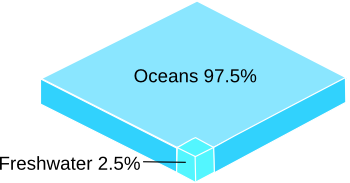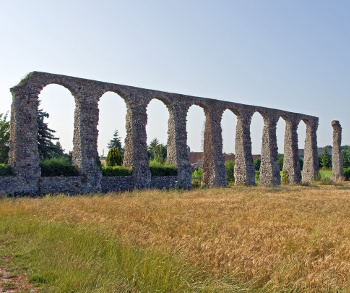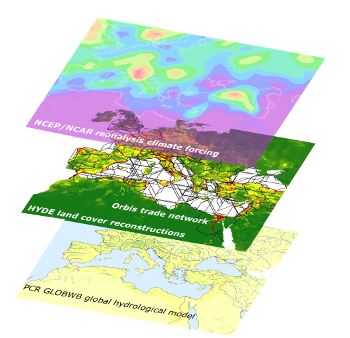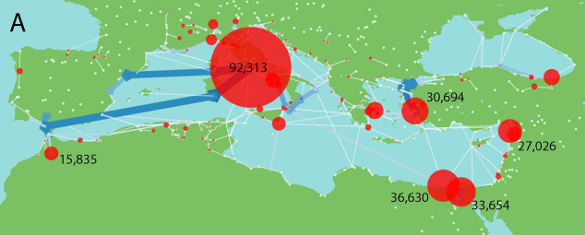Virtual Water in the Roman Empire
January 22, 2015
The
wars of yesteryear were fought over
oil, but tomorrow's wars might be fought over
water. As I wrote in a
previous article (Virtual Water, March 4, 2013), the
United Nations has projected that 1.8 billion people will face water scarcity by 2025, at which time two thirds of the
world's population may be subjected to water stress.[1] About seventy percent of China's water is polluted, and China is likely to run out of fresh water by 2030.[2]

The Earth has a lot of water, but most of it is seawater.
(Adapted from figure 4.1 of ref. 1, rendered using Inkscape.)[1)]
Water demand is rising at a rapid rate in developing countries, since water reserves once used exclusively for
farming now need to be shared with
industry.
Manufacture of an
integrated circuit requires gallons of water. There's the further problem that water from most industrial processes would return to the
environment in a
toxic state that
contaminates fresh water supplies unless it's purified. A 2009 study by the
Water Resources GroupWater Resources Group advised that "competing demands for scarce water resources may lead to an estimated 40 percent supply shortage by 2030."[3]
Water scarcity has given rise to the concept of "virtual water." The term,
virtual water, was first used in 1993 by
John Anthony Allan, a professor at
King's College London. Allan reasoned that countries in water-poor regions could "import" water by importing food. Taking wheat as an example, about 1,600
cubic meters of water are needed to produce a metric ton of wheat. This also applies to import of meat, since
livestock are fed grain with considerable virtual water content.
As mentioned in the sixteenth episode, eighth season, of the The Simpsons ("
Brother from Another Series"),
hydrological engineering was important in
antiquity, also. Remnants of
aqueducts illustrate that the
Romans practiced water resource management on a grand scale in preindustrial times. A recent study by
Dutch and
US scientists explores the water management and virtual water trading that allowed the
urbanization and
socioeconomic stability of the
Roman Empire that extended over many hundreds of years.[4-5]

A Roman aqueduct at Luynes, Indre-et-Loire, central France, the only remnant of the ancient city of Malliacum.
(Photograph by Daniel Jolivet (cropped), via the European Geosciences Union.)
The
research team of
hydrologists and Roman
historians from
Utrecht University (Utrecht, the Netherlands),
Stanford University (Palo Alto, California), and
Wageningen University (Wageningen, the Netherlands) has developed a Virtual Water Network of the Roman World to demonstrate that
irrigation and virtual water
trade allowed the Roman Empire to be resilient to
climate change from year to year.[4] However, Roman success in such matters caused the Empire to overextend itself to longer term detriment.[4] The urbanization facilitated by virtual water trade pushed the Empire to the limit of its water resources, and this resulted in an increase in import costs.[4]
The Roman Empire's domain encompassed portions of three
continents, it was home to about seventy million people, and it persisted for many
centuries.[5] The
Mediterranean region where it was sited has a variable
climate, so feeding the population was a challenge that was met for that extended period. The research investigated how this was done, and what insights the process might have on our present water economy.

Modeling the virtual water network of the Roman world. The model combines a hydrological model for calculation of grain yield and simulated grain trade in the Roman transportation network.
(Illustration from ref. 4, via the European Geosciences Union.)
The empire-wide
grain-trade
network allowed a stable food supply for all Roman
citizens; but, as a consequence of
Malthusian constraints, this stable food supply could only allow urbanization and population growth until food resources became limited.[5] This
history mirrors the same problem we face today. Says
Brian Dermody, an
environmental scientist at Utrecht University,
"We can learn much from investigating how past societies dealt with changes in their environment... For example, the Romans were confronted with managing their water resources in the face of population growth and urbanization. To ensure the continued growth and stability of their civilization, they had to guarantee a stable food supply to their cities, many located in water-poor regions."[5]
Cereal grain was the staple crop of Roman civilization, and growth of a
kilogram of grain requires about 1000-2000
liters of water. By trading grain, the Romans also traded the water needed to produce it; that is, they were trading virtual water.[5] In the virtual water network model developed by the research team, grain and its virtual water content was sent from regions such as the
Nile Basin to water-poor areas such as the
city of Rome, itself.[5]
A
hydrological model was used to calculate grain yield over the extent of the Empire, and a grain
transport model was constructed that takes into account the transportation
cost based on distance and means of transportation.[5] Optimally, says Dermody, "If grain yields were low in a certain region, they could import grain from a different part of the Mediterranean that experienced a surplus. That made them highly resilient to short-term climate variability."[5]

Virtual water imports in the Roman world. The size of the circles indicate the relative amount of virtual water exchanged. The numbers show the amount imported in tons of grain per year. The city of Rome imported the largest amount of virtual water. (Illustration from ref. 4, via the European Geosciences Union.)
As if a model case for
Malthusian economics, the stable food supply allowed for urbanization and overpopulation in the Roman Empire until a point was reached when minor shortfalls led to big problems. The study
authors find a lesson for our future virtual water management. Says Dermody,
"We're confronted with a very similar scenario today. Virtual water trade has enabled rapid population growth and urbanization since the beginning of the industrial revolution. However, as we move closer to the limits of the planet's resources, our vulnerability to poor yields arising from climate change increases."[5]
References:
- Russell Arthurton, et al., Chapter 4 - "Water" from Global Environmental Outlook - GEO4 environment for development, United Nations Environment Programme, 2007 (23.5 MB PDF file).
- Cherian Thomas, Unni Krishnan and Sophie Leung, "China-India Water Shortage Means Coca-Cola Joins Intel in Fight," Bloomberg Online (May 26, 2010).
- 2030 Water Resources Group, "Charting our water future" (2009).
- B. J. Dermody, R. P. H. van Beek, E. Meeks, K. Klein Goldewijk, W. Scheidel, Y. van der Velde, M. F. P. Bierkens, M. J. Wassen, and S. C. Dekker, "A virtual water network of the Roman world," Hydrology and Earth System Sciences, vol. 18 (2014), pp. 5025-5040, doi:10.5194/hess-18-5025-2014. This is an open access article with a PDF file available here.
- Water's role in the rise and fall of the Roman Empire, European Geosciences Union Press Release, December 11, 2014.
Permanent Link to this article
Linked Keywords: War; petroleum; oil; water; United Nations; world population; China; pollution; polluted; Earth; seawater; Inkscape; country; agriculture; farming; industry; manufacturing; integrated circuit; gallon; industrial process; environment; toxicity; toxic; contamination; contaminate; Water Resources Group; virtual water; John Anthony Allan; professor; King's College London; desert climate; water-poor; import; food; cubic meter; metric ton; wheat; meat; livestock; cereal; grain; The Simpsons; Brother from Another Series; geotechnical engineering; hydrological engineering; classical antiquity; Roman aqueduct; Romans; Dutch; United States; US; scientist; urbanization; socioeconomic; Roman Empire; Luynes, Indre-et-Loire; France; European Geosciences Union; research; hydrology; hydrologist; historian; Utrecht University (Utrecht, the Netherlands); Stanford University (Palo Alto, California); Wageningen University (Wageningen, the Netherlands); irrigation; trade; climate change; continent; century; Mediterranean Sea; climate; mathematical model; network; Roman world; hydrology; hydrological; food grain; transport; transportation; citizen; Malthusian catastrophe; Malthusian constraint; history; Brian Dermody; environmental science; environmental scientist; civilization; Cereal grain; kilogram; liter; Nile Basin; city of Rome; cost; ton; Thomas Robert Malthus; Malthusian economics; author; industrial revolution; planet.